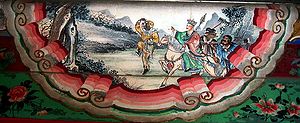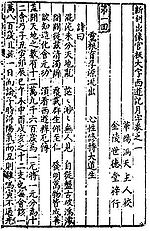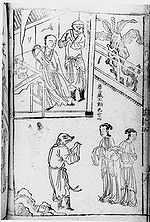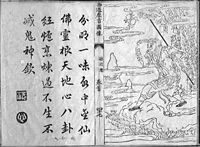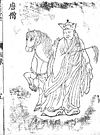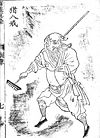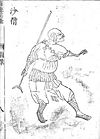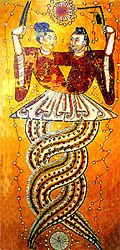Journey to the West
| Author | Wú Chéng'ēn |
|---|---|
| Original title | 西遊記 |
| Translator | many |
| Country | China |
| Language | Chinese |
| Publisher | many |
| Released | 1590s |
| Media type | Print () |
| ISBN | ISBN |
Journey to the West (Traditional Chinese: 西遊記; Simplified Chinese: 西游记; Hanyu Pinyin: Xīyóu-jì; Wade-Giles: Hsiyu-chi) is one of the Four Great Classical Novels of Chinese literature. Originally published anonymously in the 1590s during the Ming Dynasty, and even though no direct evidence of its authorship survives, it is ascribed to the scholar Wú Chéng'ēn since the 20th century.
The tale is also often known simply as Monkey. This was one title used for a popular, abridged translation by Arthur Waley; as well as being the title of the Japanese TV series based on the story. The Waley translation has also been published as Adventures of the Monkey God; and Monkey: [A] Folk Novel of China; and The Adventures of Monkey. The novel is a fictionalized account of the legends around the Buddhist monk Xuánzàng's pilgrimage to India during the Táng dynasty in order to obtain Buddhist religious texts called sutras. The Bodhisattva Guānyīn, on instruction from the Buddha, gives this task to the monk and his three protectors in the form of disciples — namely Sūn Wùkōng, Zhū Bājiè and Shā Wùjìng — together with a dragon prince who acts as Xuánzàng's horse mount. These four characters have agreed to help Xuánzàng as an atonement for past sins.
Some scholars propose that the book satirises the effete-ness of the Chinese government at the time. Journey to the West has a strong background in Chinese folk religion, Chinese mythology and value systems; the pantheon of Taoist and Buddhist deities is still reflective of Chinese folk religious beliefs today.
Part of the novel's enduring popularity comes from the fact that it works on multiple levels: it is a first-rate adventure story, a dispenser of spiritual insight, and an extended allegory in which the group of pilgrims journeying toward India stands for the individual journeying toward enlightenment.
Synopsis
The novel comprises 100 chapters. These can be divided into four very unequal parts. The first, which includes chapters 1–7, is really a self-contained prequel to the main body of the story. It deals entirely with the earlier exploits of Sūn Wùkōng, a monkey born from stone who learns the art of fighting and secrets of immortality, and through guile and force makes a name for himself as the Qítiān Dàshèng (Simplified Chinese: 齐天大圣; Traditional Chinese: 齊天大聖), or "Great Sage Equal to Heaven." His powers grow to match the forces of all of the Eastern (Taoist) deities, and the prologue culminates in Sūn's rebellion against Heaven, during a time when he garnered a post in the celestial bureaucracy. Hubris proves his downfall when the Buddha manages to trap him under a mountain for five hundred years.
Only following this introductory story is the nominal main character, Xuánzàng, introduced. Chapters 8–12 provide his early biography and the background to his great journey. Dismayed that "the land of the South knows only greed, hedonism, promiscuity, and sins," the Buddha instructs the Bodhisattva Guānyīn to search Táng China for someone to take the Buddhist sutras of "transcendence and persuasion for good will" back to the East. Part of the story here also relates to how Xuánzàng becomes a monk (as well as revealing his past life as the "Golden Cicada" and comes about being sent on this pilgrimage by the Emperor Táng Tàizōng, who previously escaped death with the help of an underworld official).
The third and longest section of the work is chapters 13–99, an episodic adventure story which combines elements of the quest as well as the picaresque. The skeleton of the story is Xuánzàng's quest to bring back Buddhist scriptures from Vulture Peak in India, but the flesh is provided by the conflict between Xuánzàng's disciples and the various evils that beset him on the way.
The scenery of this section is, nominally, the sparsely populated lands along the Silk Road between China and India, including Xinjiang, Turkestan, and Afghanistan. The geography described in the book is, however, almost entirely fantastic; once Xuánzàng departs Cháng'ān, the Táng capital and crosses the frontier (somewhere in Gansu province), he finds himself in a wilderness of deep gorges and tall mountains, all inhabited by flesh-eating demons who regard him as a potential meal, with here and there a hidden monastery or royal city-state amid the wilds.
The episodic structure of this section is to some extent formulaic. Episodes consist of 1–4 chapters, and usually involve Xuánzàng being captured and his life threatened, while his disciples try to find an ingenious (and often violent) way of liberating him. Although some of Xuánzàng's predicaments are political and involve ordinary human beings, they more frequently consist of run-ins with various goblins and ogres—many of whom turn out to be the earthly manifestations of heavenly beings.
Chapters 13–22 do not follow this structure precisely, as they introduce Xuánzàng's disciples, who, inspired or goaded by Guānyīn, meet and agree to serve him along the way, in order to atone for their sins in their past lives.
- The first is Sūn Wùkōng (Simplified Chinese: 孙悟空; Traditional Chinese: 孫悟空), or Monkey, previously "Great Sage Equal to Heaven," trapped by Buddha for rebelling against Heaven. He appears right away in Chapter 13. The most intelligent and violent of the disciples, he is constantly reproved for his violence by Xuánzàng. Ultimately, he can only be controlled by a magic gold band that the Bodhisattva has placed around his head, which causes him excruciating pain when Xuánzàng says certain magic words.
- The second, appearing in 19, is Zhū Bājiè (Simplified Chinese: 猪八戒; Traditional Chinese: 豬八戒), literally Eight-precepts Pig, sometimes translated as Pigsy or just Pig. He was previously Marshal Tīan Péng (Simplified Chinese: 天蓬元帅; Traditional Chinese: 天蓬元帥), commander of the Heavenly Naval forces, banished to the mortal realm for flirting with the Princess of the Moon Chang'e. He is characterized by his insatiable appetites for food and sex, and is constantly looking for a way out of his duties, but is always kept in line by Sūn Wùkōng.
- The third, appearing in chapter 22, is the river-ogre Shā Wùjìng (Simplified Chinese: 沙悟净; Traditional Chinese: 沙悟淨), also translated as Friar Sand or Sandy. He was previously Great General who Folds the Curtain (Simplified Chinese: 卷帘大将; Traditional Chinese: 捲簾大將), banished to the mortal realm for dropping (and shattering) a crystal goblet of the Heavenly Queen Mother. He is a quiet but generally dependable character, who serves as the straight foil to the comic relief of Sūn and Zhū.
- Possibly to be counted as a fourth disciple is the third prince of the Dragon-King, Yùlóng Sāntàizǐ (Simplified Chinese: 玉龙三太子; Traditional Chinese: 玉龍三太子), who was sentenced to death for setting fire to his father's great pearl. He was saved by Guānyīn from execution to stay and wait for his call of duty. He appears first in chapter 15, but has almost no speaking role, as throughout most of the story he appears in the transformed shape of a horse that Xuánzàng rides on.
Chapter 22, where Shā is introduced, also provides a geographical boundary, as the river of quicksand that the travelers cross brings them into a new "continent." Chapters 23–86 take place in the wilderness, and consist of 24 episodes of varying length, each characterized by a different magical monster or evil magician. There are impassably wide rivers, flaming mountains, a kingdom ruled by women, a lair of seductive spider-spirits, and many other fantastic scenarios. Throughout the journey, the four brave disciples have to fend off attacks on their master and teacher Xuánzàng from various monsters and calamities.
It is strongly suggested that most of these calamities are engineered by fate and/or the Buddha, as, while the monsters who attack are vast in power and many in number, no real harm ever comes to the four travelers. Some of the monsters turn out to be escaped heavenly animals belonging to bodisattvas or Taoist sages and spirits. Towards the end of the book there is a scene where the Buddha literally commands the fulfillment of the last disaster, because Xuánzàng is one short of the eighty-one disasters he needs to attain Buddhahood.
In chapter 87, Xuánzàng finally reaches the borderlands of India, and chapters 87–99 present magical adventures in a somewhat more mundane (though still exotic) setting. At length, after a pilgrimage said to have taken fourteen years (the text actually only provides evidence for nine of those years, but presumably there was room to add additional episodes) they arrive at the half-real, half-legendary destination of Vulture Peak, where, in a scene simultaneously mystical and comic, Xuánzàng receives the scriptures from the living Buddha.
Chapter 100, the last of all, quickly describes the return journey to the Táng Empire, and the aftermath in which each traveler receives a reward in the form of posts in the bureaucracy of the heavens. Sūn Wùkōng and Xuánzàng achieve Buddhahood, Wùjìng becomes an arhat, the dragon is made a Naga, and Bājiè, whose good deeds have always been tempered by his greed, is promoted to an altar cleanser (i.e. eater of offerings at altars).
Historical context
The classic tale of the Journey to the West was based on real events. The real journey to the west took place during the Tang Dynasty. The Big Wild Goose Pagoda in Xī'ān, Shǎnxī Province, China, was both the starting and ending point of this epic journey. The statue of Xuánzàng can be seen near the right of this panorama. Xuánzàng reached India after he experienced innumerable trials and hardships, of course without the help of the mighty disciples of the novel. Xuánzàng then lived in India for more than a decade, studying at Nalanda University and learning classics of Buddhism and Indian culture. Later he returned to China, bringing with him copies of many classic Buddhist texts, which contributed significantly to the promotion of Buddhism in China.
Fictionalized stories of Xuánzàng's journey were in existence long before Journey to the West was written. In these versions, dating as far back as Southern Song, a monkey character was already a primary protagonist. It is believed [citation needed] that these legends began forming from Xuánzàng's accounts of Hanuman, the Hindu monkey god from the ancient Ramayana epic. During the Yuan Dynasty and early Ming, elements of the Monkey legend can already be seen.
Main characters
Tripitaka or Xuánzàng
Xuánzàng (or Táng-Sānzàng, meaning "Táng-dynasty monk" — Sānzàng or "Three Baskets," referring to the Tripitaka, was a traditional honorific for a Buddhist monk) is the Buddhist monk who set out to India to retrieve the Buddhist scriptures for China. He is called Tripitaka in many English versions of the story. Although he is helpless when it comes to defending himself, the bodhisattva Guānyīn helps by finding him powerful disciples (Sūn Wùkōng, Zhū Bājiè, and Shā Wùjìng) who aid and protect him on his journey. In return, the disciples will receive enlightenment and forgiveness for their sins once the journey is done. Along the way, they help the local inhabitants by defeating various monsters. The fact that most of the monsters and demons are trying to obtain immortality by eating Xuánzàng's flesh, and are even attracted to him as he is depicted as quite handsome, provides much of the plot in the story.
Monkey or Sūn Wùkōng
Sūn Wùkōng is the name given to this character by his teacher, Patriarch Subodhi, and means "the one who has Achieved the Perfect Comprehension of the Extinction of both Emptiness and non-Emptiness"; he is called Monkey King or simply Monkey in English.
He was born out of a rock that had been dormant for ages in Bloom Mountains that was inhabited/weathered by the sun and moon until a monkey sprang forth. He first distinguished himself by bravely entering the Cave of Water Curtains (pinyin:Shuǐlián-dòng ) at the Mountains of Flowers and Fruits (Huāguǒ-shān); for this feat, his monkey tribe gave him the title of Měi-hóuwáng ("handsome monkey-king"). Later, he started making trouble in Heaven and defeated an army of 100,000 celestial soldiers, led by the Four Heavenly Kings, Erlang Shen, and Nezha. Eventually, the Jade Emperor appealed to Buddha, who subdued and trapped Wukong under a mountain. He was only saved when Xuanzang came by him on his pilgrimage and accepted him as a disciple.
His primary weapon is the rúyì-jīngū-bàng ("will-following golden-banded staff"), which he can shrink down to the size of a needle and keep behind his ear, as well as expand it to gigantic proportions (hence the "will-following" part of the name). The staff, originally a pillar supporting the undersea palace of the East Sea Dragon King, weighs 13,500 pounds, which he pulled out of its support and swung with ease. The Dragon King, not wanting him to cause any trouble, also gave him a suit of golden armor. These gifts, combined with his devouring of the peaches of immortality and three jars of immortality pills while in Heaven, plus his ordeal in an eight-trigram furnace (which gave him a steel-hard body and fiery golden eyes), makes Wukong the strongest member by far of the pilgrimage. Besides these abilities, he can also pull hairs from his body and blow on them to transform them into whatever he wishes (usually clones of himself to gain a numerical advantage in battle). Although he has mastered seventy-two methods of transformations, it does not mean that he is restricted to seventy-two different forms. He can also do a jīndǒuyún ("cloud somersault"), enabling him to travel vast distances in a single leap. Wukong uses his talents to fight demons and play pranks. However, his behavior is checked by a band placed around his head by Guanyin, which cannot be removed by Wukong himself until the journey's end. Xuanzang can tighten this band by chanting the Tightening-Crown spell (taught to him by Guanyin) whenever he needs to chastise him.
Wukong's child-like playfulness is a huge contrast to his cunning mind. This, coupled with his acrobatic skills, makes him a likeable hero, though not necessarily a good role model. His antics present a lighter side in what proposes to be a long and dangerous trip into the unknown.
Pigsy or Zhū Bājiè
Zhū Bājiè ("Pig of the Eight Prohibitions") is also known as Zhū Wùnéng ("Pig Awakened to Power"), and given the name Pigsy or Pig in English.
Once an immortal who was the Tiānpéng-yuánshuǎi ("Field Marshal Tianpeng") of 100,000 soldiers of the Milky Way, during a celebration of gods, he drank too much and attempted to flirt with Cháng'é, the beautiful moon goddess, resulting in his banishment into the mortal world. He was supposed to be reborn as a human, but ended up in the womb of a sow due to an error at the Reincarnation Wheel, which turned him into a half-man half-pig monster. Staying within Yúnzhan-dòng ("cloud-pathway cave"), he was commissioned by Guanyin to accompany Xuanzang to India and given the new name Zhu Wuneng.
However, Wuneng's desire for women led him to Gao Village, where he posed as a normal being and took a wife. Later, when the villagers discovered that he was a monster, Wuneng hid the girl away. At this point, Xuanzang and Wukong arrived at Gao Village and helped subdue him. Renamed Zhu Bajie by Xuanzang, he consequently joined the pilgrimage to the West.
His weapon of choice is the jiǔchǐdīngpá ("nine-tooth iron rake"). He is also capable of thirty-six transformations (as compared to Wukong's seventy-two), and can travel on clouds, but not as fast as Wukong. However, Bajie is noted for his fighting skills in the water, which he used to combat Sha Wujing, who later joined them on the journey.
Sandy or Shā Wùjìng
Shā Wùjìng (literally meaning "Sand Awakened to Purity"), given the name Friar Sand or Sandy in English, was once the Curtain Raising General, who stood in attendance by the imperial chariot in the Hall of Miraculous Mist. He was exiled to the mortal world and made to look like a monster because he accidentally smashed a crystal goblet belonging to the Heavenly Queen Mother during the Peach Banquet. The now-hideous immortal took up residence in the Flowing Sands River, terrorizing the surrounding villages and travelers trying to cross the river. However, he was subdued by Sūn Wùkōng and Zhū Bājiè when the Sānzàng party came across him. They consequently took him in to be a part of the pilgrimage to the West.
Shā Wùjìng's weapon is the yuèyáchǎn ("Crescent-Moon-Shovel" or "Monk's Spade"). Aside from that, he knows eighteen transformations and is highly effective in water combat. He is about as strong as Bājiè , and is much stronger than Wùkōng in water. However, Bājiè can beat Wujing in a test of endurance, and Wùkōng can beat him out of water.
Shā Wùjìng is known to be the most obedient, logical, and polite of the three disciples, and always takes care of his master, seldom engaging in the bickeries of his fellow-disciples. Ever reliable, he carries the luggage for the travellers. Perhaps this is why he is sometimes seen as a minor character; the lack of any particular perks confers the lack of distinguishing and/or redeeming characteristics.
Wùjìng eventually becomes an Arhat at the end of the journey, giving him a higher level of exaltation than Bājiè, who is relegated to cleaning every altar at every Buddhist temple for eternity, but is still lower spiritually than Wùkōng or Sānzàng who are granted Buddhahood.
List of Demons
There are many demons in the story. They are listed below:
- Black-Bear-Demon (pinyin: Hēixióngguǐ)
- Yellow Wind Demon (Huáng Fung Guǐ)
- Zhen Yuan Holy Man (He is not a demon, but an immortal, who got annoyed by those disciples who stole his previous immortal-fruits.)
- White-Bone-Demon (pinyin: Báigǔjīng)
- Yellow Robe Demon (pinyin: Huángpáoguǐ)
- Gold-Horn and Silver-Horn (pinyin: Jīnjiǎo and Yínjiǎo)
- Red-Boy a.k.a. Holy Baby King (pinyin: Hóng-hái'ér; Japanese: Kōgaiji)
- Tiger Power, Deer Power and Goat (or Antelope) Power
- Black River Dragon Demon (Hēi Shui Hé Yuan Lóng Guǐ)
- Carp Demon (Li Yu Jīng)
- Green-Ox-Demon (pinyin: Qīngniújīng)
- Scorpion-Demon (pinyin: Xiēzijīng)
- Six Ear Monkey Demon a.k.a Fake Sun Wukong
- Ox-Demon-King (pinyin: Niúmówáng; Japanese: Gyūmaō)
- Demon Woman (Luo Cha Nǚ)
- Jade-Faced Princess (pinyin: Yùmiàn-gōngzhǔ; Japanese: Gyokumen-kōshū)
- Boa Demon (Hong She Jīng)
- Nine-Headed Bird Demon (Jiǔ Tou Fu Ma)
- Seven-Spider-Demons (pinyin: Zhīzhū-jīng)
- Hundred-Eyed Taoist (Bǎi Yan Mo Jun)
- Green Lion Demon (pinyin: Qīngshījīng)
- White-Elephant-Demon (pinyin: Báixiàngjīng)
- Falcon Demon (Sun Jīng)
- Biqiu Country Minister a.k.a Deer Demon
- Gold-Nosed, White Mouse Demon (Lao Shu Jīng)
- Dream-Demon
Notable English-language translations
- Monkey: A Folk-Tale of China (1942), an abridged translation by Arthur Waley. For many years, the best translation available in English; it only translates thirty out of the hundred chapters. (Penguin reprint ISBN 0-14-044111-5)
- Journey to the West, a complete translation by W.J.F. Jenner published by the Foreign Languages Press in Beijing 1955 (three volumes; 1982/1984 edition: ISBN 0-8351-1003-6, ISBN 0-8351-1193-8, ISBN 0-8351-1364-7)
- The Journey to the West (1977–1983), a complete translation in four volumes by Anthony C. Yu.
University of Chicago Press: HC ISBN 0-226-97145-7, ISBN 0-226-97146-5, ISBN 0-226-97147-3, ISBN 0-226-97148-1; PB ISBN 0-226-97150-3, ISBN 0-226-97151-1; ISBN 0-226-97153-8; ISBN 0-226-97154-6. This translation has good reviews, but is much more costly than Jenner's.
Media adaptations
Comics, manga and anime
- Alakazam the Great: One of the first anime films produced by Toei Animation, a retelling of first part of the story based on the characters designed by Osamu Tezuka.
- American Born Chinese: An American graphic novel by Gene Yang. Nominated for the National Book Award (2006).
- Doraemon: A special tells the story of Journey To The West casting the Doraemon characters as the characters of the legend.
- Dragon Ball: Japanese manga and anime series loosely inspired by Journey to the West.
- Eyeshield 21: Three of the players for the Shinryuji Nagas are referred to as the Saiyuki Trio based upon their appearances and personalities.
- Excel Saga: Excel (dressed as monkey) starts a "discipleship" with a girl (dressed as Tripitaka).
- Gensōmaden Saiyūki: manga and anime series inspired by the legend. Follow-up series include Saiyūki Reload and Saiyūki Reload Gunlock.
- Havoc in Heaven (also known as Uproar in Heaven): Original animation from China.
- InuYasha: The characters meet descendants of three of the main characters of the Journey of the West in one episode and main character, Kagome Higurashi, says a few lines about the whole book and story.
- Kaleido Star: The cast performs Saiyuki on stage a few times in the beginning of the second half of the series.
- Love Hina: The characters put on a play based on the story in anime episode 16.
- Monkey Magic: An animated retelling of the legend.
- Monkey Typhoon: A manga and anime series based on the Journey to the West saga, following a futuristic steampunk-retelling of the legend.
- Naruto: Temari, a character from Naruto, is based on Princess Iron Fan from the legend. Enma is a summoned monkey who bears resemblance to Sun Wukong. He has the ability to transform into a staff similar to the rúyì-jīngū-bàng, which can alter its size at will.
- Paprika: A standalone movie where the main character, Paprika/Chiba, has the antics/cunning duality of the Monkey-king; in one scene Paprika rides a cloud wielding a staff.
- Patalliro Saiyuki: A shōnen-ai series in both anime and manga formats with the Patalliro cast playing out the Zaiyuji storyline with a yaoi twist.
- Ranma 1/2: Pastiches of the characters appear throughout the manga and movies.
- "Saiyuki"
- Shinzo: An anime loosely based on Journey to the West.
- Starzinger: An animated science fiction version of the story.
- The Monkey King: A gruesome manga inspired by the tale.
- XIN: An American comic mini-series produced by Anarchy Studio.
Film
- A Chinese Odyssey by Stephen Chow.
- A Chinese Tall Story: 2005 live action movie starring Nicholas Tse as Xuánzàng.
- Heavenly Legend: A 1998 film by Tai Seng Entertainment starring Kung Fu kid Sik Siu Loong is partially based on this legend.
- Monkey Goes West: The Shaw Brothers's 1966 Hong Kong film (Cantonese: Sau yau gei. Also known as "Monkey with 72 Magic"
Games
- Yuu Yuu Ki: A video game for the Famicom Disk System, based directly on the story.
- Pokémon Diamond and Pearl: A video game and multiseries in which the Pokémon creatures Chimchar, Monferno, and mainly Infernape are based on Sūn Wùkōng.
- Rai Rai Gokuu: A Japanese pachislot (pachinko slot machine) with this theme.
- Saiyuki: Journey West: A tactical role-playing game (RPG) videogame for the PlayStation developed by KOEI.
- SonSon: A video game and character of the same name created by Capcom whose title character is a female version of Sūn Wùkōng.
- Soul Calibur: A series of video games by Namco features the character Kilik, who wields a staff. In the second installment to the series (not including its prequel, Soul Blade), Kilik's ultimate weapon is called the Jingu Staff, a reference to Son Wukong's rúyì-jīngū-bàng. In Soul Calibur III, custom characters can use the Staff discipline, allowing them to wield a staff that can change its length and thickness.
- Westward Journey: A massively multiplayer online role-playing game (MMORPG).
- Genso Suikoden II: The main character's head ring is identical to that of Sūn Wùkōng.
Live action television
- Journey to the West: A Chinese 1986 live action series and some other adaptations.
- Journey to the West: A two-part television series produced by Hong Kong studio, TVB.
- Monkey: The well-known 1970s Japanese television series based on Journey to the West translated into English by the BBC.
- The Monkey King: Sci Fi Channel's TV adaptation of this legend, also called The Lost Empire.
- Saiyūki: A 2006 Japanese television series starring the SMAP star Shingo Katori.
Stage
- Journey to the West: The Musical: A stage musical which received its world premiere at the New York Musical Theatre Festival on September 25, 2006.
- Monkey: Journey to the West: A stage musical version is currently in development by Damon Albarn and Jamie Hewlett. It premiered as part of the 2007 Manchester International Festival at the Palace Theatre on June 28.
External links
- Monkey, Journey To The West opera on BBC Imagine...
- Monkey - Great Sage equal of Heaven - fansite.
- Journey to the West - Freeware complete English text version in PDF format (2.56MB). From Chine Informations
- Journey to the West - Comprehensive and detailed website with in-depth information about Journey to the West.
- Story of Sun Wukong and the beginning of Journey to the West with manhua
- Complete novel in Simplified Characters (utf-16 encoding).
- A recent Hong Kong film based on one episode in the journey - see also here for images A Chinese Tall Story (Ching din dai sing).
- Television Series: Most Popular CCTV Series, Xi You Ji
- Journey to the West - The Musical -The stage musical currently in development.
- Monkey Heaven A site with extensive information on the television adaptation, Monkey Magic.
- Solarguard Monkey Plot summary (one paragraph for each of one hundred in novel) plus summary of book on historical Xuanzang.
| |||||
| General topics: | Creation myth · Astrology · Dragons · Religion in China Folk religion ·List of deities · I Ching | ||||
| Important beings: | Deities · Three Sovereigns and Five Emperors · Eight Immortals | ||||
| Mythical creatures: |
Xuán Wǔ · Qīng Lóng · Bái Hǔ · Zhū Què | ||||
| Mythical places: | Xuanpu · Yaochi · Fusang · Queqiao Penglai · Longmen · Diyu | ||||
| Literary sources: | Shan Hai Jing · Shui Jing Zhu · Ten Brothers · Hei'an Zhuan Fengshen Yanyi · Journey to the West · Baishe Zhuan Strange Stories from a Chinese Studio | ||||
mn:Баруун этгээдэд зорчсон тэмдэглэл
Credits
New World Encyclopedia writers and editors rewrote and completed the Wikipedia article in accordance with New World Encyclopedia standards. This article abides by terms of the Creative Commons CC-by-sa 3.0 License (CC-by-sa), which may be used and disseminated with proper attribution. Credit is due under the terms of this license that can reference both the New World Encyclopedia contributors and the selfless volunteer contributors of the Wikimedia Foundation. To cite this article click here for a list of acceptable citing formats.The history of earlier contributions by wikipedians is accessible to researchers here:
The history of this article since it was imported to New World Encyclopedia:
Note: Some restrictions may apply to use of individual images which are separately licensed.
